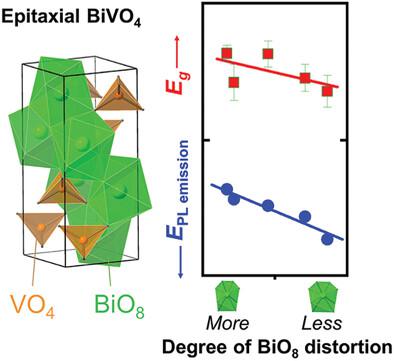当前位置:
X-MOL 学术
›
Adv. Energy Mater.
›
论文详情
Our official English website, www.x-mol.net, welcomes your feedback! (Note: you will need to create a separate account there.)
Strain-Induced Distortions Modulate the Optoelectronic Properties of Epitaxial BiVO4 Films
Advanced Energy Materials ( IF 27.8 ) Pub Date : 2023-05-24 , DOI: 10.1002/aenm.202301075 Erwin N. Fernandez 1, 2 , Daniel A. Grave 3 , Roel van de Krol 1, 2 , Fatwa F. Abdi 1
Advanced Energy Materials ( IF 27.8 ) Pub Date : 2023-05-24 , DOI: 10.1002/aenm.202301075 Erwin N. Fernandez 1, 2 , Daniel A. Grave 3 , Roel van de Krol 1, 2 , Fatwa F. Abdi 1
Affiliation

|
Transition metal oxide (TMO) photoabsorbers are expected to play an important role in the development of renewable solar-to-fuel devices. Modest efficiencies have been demonstrated with devices based on TMO photoabsorbers, and further progress will likely rely on material property control beyond conventional bulk chemistry or nanostructuring strategies. To this end, model TMO photoabsorbers such as single crystalline monoclinic bismuth vanadate (BiVO4) are beneficial to advance the understanding of structure-functionality relationships with minimal convoluted effects inherent in polycrystalline systems. Here, the authors reveal for the first time the effects of strain modulation strategies on the optoelectronic properties of epitaxial BiVO4 films synthesized by alternate-target layer-by-layer pulsed laser deposition. Through a combination of high-resolution X-ray diffraction methods and optical and photoluminescence spectroscopies, the correlation between anisotropic, uniaxial strain-driven bandgap widening and deviatoric strains associated with volume-preserving lattice distortions is established. Broad polaronic photoluminescence signals are detected in epitaxial BiVO4, and its redshift is attributed to the structural distortion in BiO8 dodecahedra. Overall, the relationship between the structural and optoelectronic properties revealed in this study suggests that strain modulation and engineering of local distortion in complex transition metal oxides may be exploited as a viable strategy for the development of efficient photoabsorbers.
中文翻译:

应变引起的畸变调节外延 BiVO4 薄膜的光电性能
过渡金属氧化物(TMO)光吸收剂预计将在可再生太阳能发电装置的开发中发挥重要作用。基于 TMO 光吸收剂的设备已经证明了适度的效率,进一步的进展可能依赖于传统本体化学或纳米结构策略之外的材料特性控制。为此,诸如单晶单斜钒酸铋(BiVO 4)等模型TMO光吸收剂有利于促进对结构-功能关系的理解,同时将多晶系统固有的复杂效应降至最低。在这里,作者首次揭示了应变调制策略对外延 BiVO 4光电特性的影响通过交替靶逐层脉冲激光沉积合成的薄膜。通过结合高分辨率 X 射线衍射方法以及光学和光致发光光谱,建立了各向异性、单轴应变驱动的带隙加宽和与体积保持晶格畸变相关的偏应变之间的相关性。在外延BiVO 4中检测到宽极化光致发光信号,其红移归因于BiO 8的结构畸变。十二面体。总体而言,本研究揭示的结构和光电特性之间的关系表明,复杂过渡金属氧化物中的应变调制和局部变形工程可以作为开发高效光吸收剂的可行策略。
更新日期:2023-05-24
中文翻译:

应变引起的畸变调节外延 BiVO4 薄膜的光电性能
过渡金属氧化物(TMO)光吸收剂预计将在可再生太阳能发电装置的开发中发挥重要作用。基于 TMO 光吸收剂的设备已经证明了适度的效率,进一步的进展可能依赖于传统本体化学或纳米结构策略之外的材料特性控制。为此,诸如单晶单斜钒酸铋(BiVO 4)等模型TMO光吸收剂有利于促进对结构-功能关系的理解,同时将多晶系统固有的复杂效应降至最低。在这里,作者首次揭示了应变调制策略对外延 BiVO 4光电特性的影响通过交替靶逐层脉冲激光沉积合成的薄膜。通过结合高分辨率 X 射线衍射方法以及光学和光致发光光谱,建立了各向异性、单轴应变驱动的带隙加宽和与体积保持晶格畸变相关的偏应变之间的相关性。在外延BiVO 4中检测到宽极化光致发光信号,其红移归因于BiO 8的结构畸变。十二面体。总体而言,本研究揭示的结构和光电特性之间的关系表明,复杂过渡金属氧化物中的应变调制和局部变形工程可以作为开发高效光吸收剂的可行策略。



























 京公网安备 11010802027423号
京公网安备 11010802027423号